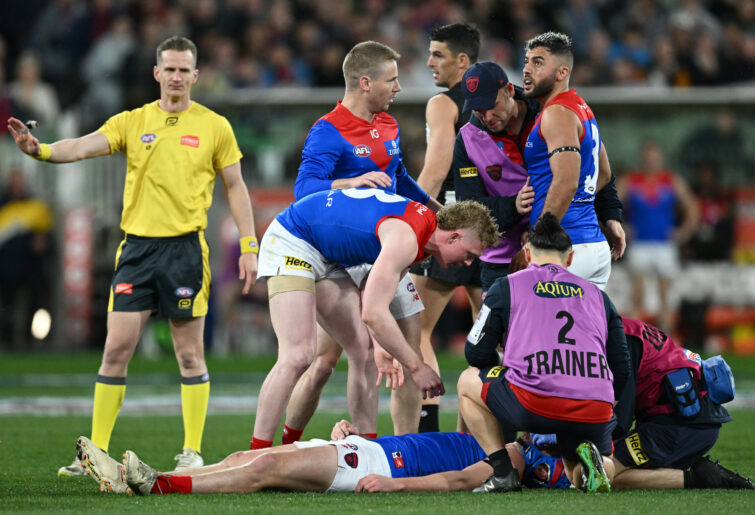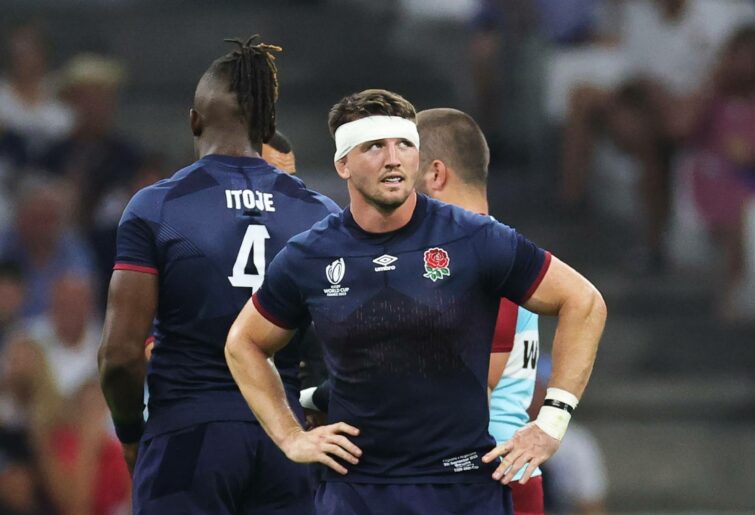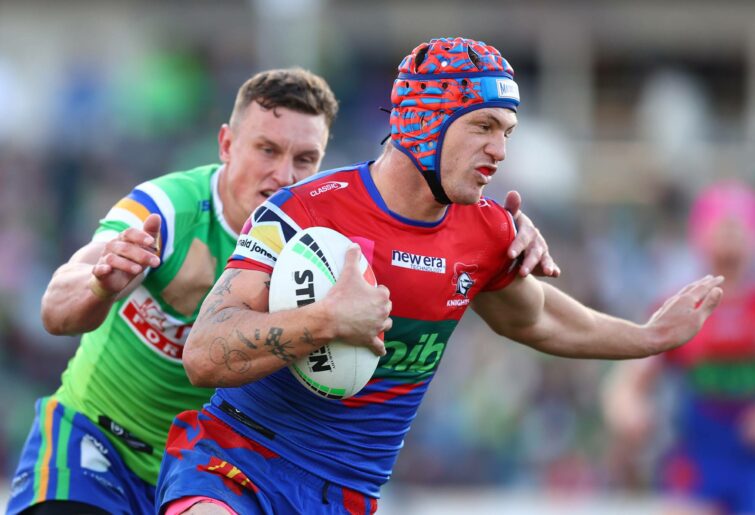Another week, another player damaged to the extent his playing career is called into question.
Another week, another media frenzy tapping into the emotions of invested fans, hitting all the right notes to keep the issue of ‘fairness’ front and centre.
Another week of the point being totally missed.
Which sport am I talking about? Take your pick, it doesn’t matter which one.
The AFL’s Brayden Maynard collecting Angus Brayshaw in the head in a ‘Superman’ act gone wrong; Tom Curry lasting just three minutes of England’s Rugby World Cup opener against Argentina; Jared Waerea-Hargreaves sitting out finals, because he decided he’d rather have a crack at the heads of a few Wests Tigers players?
Or what about soccer, where in the recent Women’s World Cup, the pinnacle of the sport, a farcical pitchside assessment of a concussion saw an injured player returned to the field within 60 seconds?
Which week am I talking about? Again, it could be any; perhaps the one where two Port Adelaide players knocked each other out, yet one reappeared within six minutes, without having undergone an HIA, and the other passed an HIA, but later complained of suffering a migraine?
Where everyone jumped to the defence of the club doctor, knocking each over in the rush to assert what a good bloke he was and how seriously he took his job.
It’s a situation described by frustrated leading concussion researcher and advocate, Dr Adrian Cohen, as “just another week where Australia’s four football codes seek to prove who can dive deepest into the bottom of the concussion management black hole.”

Angus Brayshaw was knocked unconscious in a collision with Brayden Maynard. (Photo by Quinn Rooney/Getty Images)
Nothing could have been more predictable than the Maynard/Brayshaw matter, and Maynard’s subsequent exoneration at the tribunal, degenerating into a black and white versus red and blue and, for neutrals, a ‘what else was he supposed to do?’ affair.
In doing so, this incident became just another in a long line of illustrations of the uncanny ability of our football codes to wallow in all matters except for those that actually matter.
After all, when the AFL’s supposedly premier journalist, Caroline Wilson, finds a story of import in Maynard’s peace offering of flowers not even making Brayshaw’s vase, we can comfortably conclude that all hope for rational analysis of the real issue – how to make our sports safer without losing their essence – has been lost.
Never before in the history of contact football codes has brave, considered leadership been needed as much as it is now. From administrators, media, senior coaches, player advocates and players themselves.
With ongoing research into the causes and effects of CTE continuing, Australian rules football, rugby league and rugby union are on the verge of existential crises they purport to acknowledge, but barely understand.
Slow to the party, mainstream media now regularly tell the stories of sportspeople – professional and amateur – whose lives, and their families’ lives, have been destroyed by chronic debilitating conditions; early onset dementia, Alzheimer’s, Epilepsy, chronic headaches and, in increasing numbers, CTE.
In some cases, this has been a precursor to suicide; Heather Anderson, Paul Green, Shane Tuck, Danny Frawley and Billy Guyton just some of the high-profile examples.
In other cases, the affected cop their conditions on the chin and, along with their families, wonder how it all got to this, and why more isn’t being done to prevent others from suffering.
Which leads us to the point. Media that might otherwise hold organisations to account have neither the expertise nor the motivation to do so. Large chunks of Australia’s sports media remain wilfully ignorant of the detail, while their bosses are compromised by multi-million dollar pecuniary interests in the very same sports.
Governments, likewise, have proven equally impotent. While the recent Australian Senate Committee report into concussion in sport offered up a handful of useful recommendations, according to leading neurophysiologist Professor Alan Pearce, most “lacked sufficient detail and rigour, and weren’t worded strongly enough to impose any sense of obligation or urgency upon sports to change their approach.”
Despite good intentions, with the committee unable to compel an organisation like the NRL to attend in a genuine capacity, nor subpoena concussion doctors Paul McCrory and Andrew Gardner, what hope is there of any recommendation, even if legislated, actually shifting the dial for participants?
Without compulsion, without demands of accountability from mainstream media, sports are free to blunder along, tinkering with a rule change here or there, offering thoughts and prayers to the fallen, before kicking the can further along the road. To a place where their underwriters, one day on the wrong end of a class action judgment, might finally insist upon responsible action.
Filling the vacuums that are allowed to exist, public debate becomes mired in the minutiae of player actions, intent and the fairness of judiciary outcomes.
Hence the elevation of legal, scientific and medical experts like biomechanist Associate Professor Michael Cole, who, in support of Maynard, said: “Once airborne, Mr Maynard had no opportunity to avoid the collision,” while also claiming Maynard almost certainly had no time to contort his body to avoid colliding with Brayshaw.
“Based on the numbers and based on the research, it’s difficult to conclusively say Mr Maynard would have been able to make any conscious decision to reposition his body,” Professor Cole said when questioned by the tribunal.

Brayden Maynard and Jack Viney fight. (Photo by Quinn Rooney/Getty Images)
Imagine if the time and money invested into these arguments went towards measures to make the sports safer to play? Constructive, independent research that is; not window-dressing thinly disguised as studies that use in-house doctors, with pre-determined, indistinct outcomes already baked in.
Where in all of the Maynard/Brayshaw furore is the obvious question being asked: ‘if such collisions are unavoidable when players become airborne at speed, to what extent might the sport be compromised or damaged if the AFL prevents it happening in the first place?’
It was a similar story in France, despite rugby being further along the road in understanding the issue than the AFL, and a continent ahead of the NRL. Debate centred around Curry’s lack of intent to injure Puma’s player Juan Cruz Mallia, and the need to better distinguish between so-called ‘rugby incidents’ and actual foul play.
A month ago, it was the treatment of England captain Owen Farrell, raising the same heckles. As sure as eggs, in a tournament as intense as this World Cup is, next week, it will be someone else.
Without a cohesive, all-embracing strategy in place, with World Rugby relying on match officials and judiciary panels to do their bidding, it is undeniable that banning Curry for six weeks, or none, or the two he eventually got, will have no bearing whatsoever on the safety and health of future participants.

Tom Curry (Photo by David Rogers/Getty Images)
For this to happen, the custodians of each sport must find it within themselves to do two things;
The first is to own the issue. Not in a ‘big tobacco’ harm minimisation kind of way, but genuine ownership and acceptance of the responsibility to make change for the better.
Secondly, the way to do this is via the appointment of a senior person, just below CEO level – a concussion or head injury commissioner if you like – with real autonomy, to lead change inside and outside the organisation.
They all have the money; it’s sitting there now in the legal and ‘brand management’ buckets.
Only then, can policies be coherently devised and monitored, and the tricky detail around the implementation of safety measures without unintended deleterious consequences for the sports, be tackled with vigour.
Only then, can the right balance be found between the need for sports to maintain independent judicial processes, whilst retaining alignment with stated safety objectives.
Only then, can there be sensible delineation and the devising of specific solutions for one-off concussion events, and player management through those, and the issue of CTE being caused by the accumulation of sub-concussive hits over the lifetime of a player’s career being adequately addressed.

(Photo by Mark Nolan/Getty Images)
Only then, can the education process – of coaches, players, media and fans – be tackled in earnest, so that there is better communication, increasingly more accord, and less arguing and going off on emotional tangents each time a head injury occurs.
Such appointments would also provide an opportunity for sports to work more closely together. The senate committee hearing starkly exposed almost all of Australia’s major sports as having very little understanding of what occurs within their sports at grassroots level, and worse, even less control over monitoring and managing processes and outcomes.
Sports genuine about improving safety outcomes should be eager to learn from each other’s challenges, mistakes and successes.
It goes further. Everyone with an interest in the Maynard case could have saved themselves a whole lot of grief if they had been familiar with rugby’s recent Juan Cruz Mallia/Grant Williams case, from an Argentina versus South Africa Test match. Yes, the same Mallia, this time the victim not the transgressor.
It’s easy to imagine the tut-tutting from AFL personalities, keen to point out how rugby is of little consequence, and how its rules are different to ‘our game’. Yet the two incidences weren’t just similar, they were exactly the same.
It matters not for the brain health of Brayshaw and Williams that their trauma was a result of a flying charge-down attempt in the AFL or in a rugby Test match, but that their sports have failed them.
Imagine Andrew Dillon, Laura Kane, Peter V’landys, Andrew Abdo, Hamish McLennan and Phil Waugh closeted away in a boardroom, having a genuine crack at helping each other not only save Australian contact sports, but evolve them in a way that ensures healthy outcomes for all.
Without their lawyers, but with people from within the sports with the foresight and expertise to construct workable solutions.
It’s a ridiculous proposition, of course, not just because there would be no room big enough to accommodate all those egos.

(Photo by Matt King/Getty Images for Rugby Australia)
But because these are inherently conservative organisations, more focused on protecting their brand image and growing their revenue streams than opening their souls and protecting their body of seriously injured players from growing even larger.
It is clear that, even with looming court actions in AFL and rugby union, there are insufficient levers to trigger change from outside of the sports. That change can only come from within.
Without bold and brave leadership, this feels like incremental generational change at best.
For the sake of players who, in the meantime, continue to be exposed to significant risk, progress needs to happen at a much faster rate.

































































































